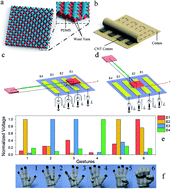Fabric-based self-powered noncontact smart gloves for gesture recognition†
Abstract
Fiber-based wearable electronics is a promising field primarily due to its capability of including multiple physical quantities for sensing. This paper presents a pair of fiber-based self-powered noncontact smart gloves with the unique function of recognizing a wide range of gestures without contact between fingertips and the palm. The one-dimensional noncontact localizing method has two working modes to distinguish the coordinate parallel or perpendicular to the direction of motions, with resolutions of 0.76 mm and 0.36 mm, respectively. Adopting a novel noncontact sensing mechanism based on electrostatic induction and triboelectric effects, such smart gloves outcompete other approaches relying on integrating contact sensing units and attaching strain or pressure sensors on human skins. It further solves the problem of electrode number reduction and energy supply, as well as improves user interaction experience. In addition, accommodation of flexible electrode configurations and gesture recognitions is innovatively proposed to enhance signal-noise ratio and reduce electrode numbers. The smart gloves consist of an electrified layer made of wool yarn and polydimethylsiloxane (PDMS) coated wool yarn, and an effective sensing layer on the palm, where electrodes made of carbon nanotubes (CNT) coated cotton fabric are sewn. With eminent characteristics such as flexibility, compatibility with human skin and less number of electrodes, these smart gloves provide excellent sensing ability and interaction experience in gesture recognition.



 Please wait while we load your content...
Please wait while we load your content...